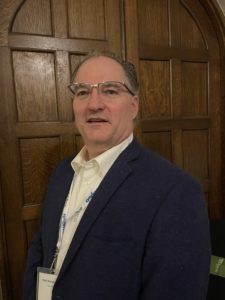The Field Crop Development Centre is settling into its new home at Olds College with a refocus on what research it does.
Editor’s note: This interview has been edited for length and clarity.
Mark MacNaughton is the program director at the Field Crop Development Centre (FCDC) at Olds College in Lacombe, Alta. He has been with FCDC for the past decade running the centre. Before that he worked as a rancher and in various positions with the provincial government from a beef and forage specialist to managing the Ag Info Centre.
Alberta Seed Guide (ASG): What’s the Field Crop Development Centre?
Mark MacNaughton (MM): The Field Crop Development Centre is a plant breeding group with the main focus on barley, but also we do triticale. We look to meet the needs of the ag industry for feed and food with these crops. We also have several labs that are focused on seed quality, pathology, and biotechnology. These labs are needed to support the breeding program as breeding is much more than what happens in the field.
The Centre was actually started with an initial investment from the hog growers of Alberta back in ’73. They were looking for greater feed varieties of barley that were adapted to Alberta and asked the provincial government for assistance. They were looking for a made at home solution versus at that time the only place in breeding barley I believe was the U of S in Saskatoon and Ag Canada in Brandon. So FCDC was created — focusing at that point mainly on barley.
ASG: FCDC was transferred from the provincial government to Olds College in 2020, when the government were stepping back from ag research. Why was it transferred to Olds?
MM: That’s a very interesting question and actually lots of folks wondered that. How Olds College looked at this was they’re saying, okay so Olds College is becoming far greater focused on ag and applied ag research. Their Smart Farm platform is a really great foundation, and they’ve really been building on that in the last five years.
They didn’t have any history in any area of the genetic works. It was an opportunity, as the government was transitioning out of it. They saw it as a complement to the overall direction of the college and felt it actually could be one of the pillars within their portfolio. They reached out and worked with the government to make that transition happen.
ASG: How has the transition gone?
MM: Shifting from the administration within a government to switching to a post-secondary system has been quite different considering what we’re used to. We had a reduction in staff, we have 22 staff now consisting of technical and scientific management and administrative people. We do have a complement of seasonal and summer students that assist as needed. And actually we completed the same amount of work we did in 2019 as far as fieldwork and lab work.
I do have to say the flexibility and the time that it takes for us to move on a decision is much quicker and much more responsive. And so we’re starting to settle into that… We had a huge amount of assistance from Olds College, from their IT, their HR, their management side, the other supporting groups to help us to work in collaboration online, it’s gone very well. Is it totally complete? Not quite, but there’s not a whole lot more to do on that.
ASG: What changes have been made at FCDC?
MM: Within the scientific side, we’ve refocused especially in our barley area. We now have a realignment of the breeding programs into two clear streams — feed and forage, and malt. Triticale is again carried on, where the thing we changed there was we’re out of doing winter triticale. So the winter annual program is wrapping up.
A major effort which will affect some change is we’ve just completed was our strategic plan in October, which began in January. And right now we’re in the middle of doing our business plan to support that. It’ll flesh out the components of the plan where we’ve got our strategic drivers, the objectives, the actions and what success looks like through measures. So that’s the next step that we’re looking to complete. The timeline for that is early in 2022.
ASG: How does the new relationship between Olds College and FCDC work?
MM: The big difference is a lot of communication of the forward plan. The strategic and business plan will be the road map. The government was going through a very introspective period of looking to focus and work on the things that were a prior priority for them. Research became less of one and they looked for areas where they could transition as much of the existing capacity as they could. FCDC was one of their assets that was divested to other institutions. And so we’ve been handed off, continued to be supported with a lot of the infrastructure that still is owned by the government. The other part is Olds College, we’re in an organization now which is looking long into the future.
We’re just starting to integrate with the other parts of Olds College such as the Olds College Centre of Innovation, their Smart Farm, and the cattle operation. We are looking to collaborate more as collectively between us there are overlapping skills and expertise that will be woven together. A couple of examples would be the feed component elements of the cattle research program, and how they are able to test their technical applications for agronomic work. Again back to the Smart Farm where we’re already planning potential use of drones to help assist in doing a lot of the field work in perhaps a speedier way or actually even a better way. It’s a broader and more collaborative relationship on many fronts as that capacity was not within the government.
ASG: What work is FCDC currently focusing on doing?
MM: The shift within our group began within our two breeding programs, and we did a lot of this work in the first year. We are refocusing within those programs to meet what the industry needs are. So that’s another component where we’re continuing to have those conversations with the industry — to sit down and talk about where their goals are and where our goals are. And when we start to see some areas of overlap out of it, how do we work together to make that work for each of us? So that’s ongoing work that we will be building out.
I guess there was another hangover as the government was working on what their direction was going to be. For several years we couldn’t get any research commitments because of the government not wanting to commit to long term agreements. So we were in a bit of a black hole. Now and evidenced by this past year, we’ve signed research agreements that are multi-year and began this year. Again the industry is starting to understand yes we’re going to be here, yes we’re open for business, and how can we work to help you guys.
ASG: Is there anything else you’d like to add?
MM: Well besides the plant breeders in their scientific capacity, we also have supporting labs of pathology, quality and biotech. They’re also looking to work better with outside organizations to support the breeding area in a broader range for industry improvement than we’ve been able to before. For all of us, that’s where we’re really starting to explore how does that look for us? We’ll continue to look at new ways of doing things with all of our partners from collaborators to funders. The landscape is changing from what we’ve done for the last 10 or 20 years as far as working and funding this research.
Related Articles
Olds College Brewery Launches Traceable Beer Using Blockchain Technology





